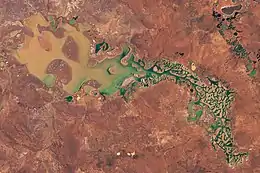Lake Carnegie (Western Australia)
Lake Carnegie is a large ephemeral lake in the Shire of Wiluna in the Goldfields-Esperance region of Western Australia. The lake is named after David Carnegie, who explored much of inland Western Australia in the 1890s.[1][2][3][4] A similar lake lies to its south east - Lake Wells.
| Lake Carnegie | |
|---|---|
 | |
 Lake Carnegie Location in Western Australia | |
| Location | Goldfields-Esperance, Western Australia |
| Coordinates | 26°10′S 122°30′E |
| Type | Ephemeral |
| Basin countries | Australia |
| Max. length | 100 km (62 mi) |
| Max. width | 30 km (19 mi) |
| Surface area | 5,714 km2 (2,206 sq mi) |
| Surface elevation | 439 m (1,440 ft) |
Description
Lake Carnegie is predominantly surrounded by desert environments.[5] It lies east of Wiluna, at the southern edge of the Little Sandy Desert, and at the southwestern border of the Gibson Desert. It is northeast of Leonora and northwest of the Great Central Road and the Great Victoria Desert. Lake Carnegie is north of the main region of gold fields in Western Australia.[6]
The lake is approximately 100 kilometres (62 mi) in length and approximately 30 kilometres (19 mi) at its widest part. It has a total area of approximately 5,714 square kilometres (2,206 sq mi),[7][8] making it one of the largest lakes in Australia. The surface elevation is 439 m (1,440 ft) above mean sea-level.[9]
Lake Carnegie fills with water only during very rare periods of significant rainfall, such as during the huge 1900 floods, and in numerous recent tropical wet seasons when climate change has moved the monsoon and tropical cyclones south. In dry years, it is reduced to a muddy marsh.
In 1973 Tropical Cyclone Kerry crossed the northwest coast and moved southwest as far as the northern gold fields. Over a four-day period, nearby pastoral leases such as Windidda Station received falls of 310 millimetres (12 in), while Prenti Downs received 209 millimetres (8 in). The runoff was enormous, causing widespread flooding, with the lake overflowing and leaving the area between Carnegie and Wiluna "one huge lake".[10]
Water entering the lake, unlike in more easterly playas of the Australian arid zone, does not come from well-defined river channels. The soils of the region are so weathered – lacking tectonic or glacial activity since the Carboniferous ice ages – that sediment is completely absent; the terrain is so flat that only the rocks most impervious to weathering remain on the surface. Well-defined river channels cannot form, especially since the extreme age of the soils and consequent high rooting density of native flora limit runoff to an extreme degree.
Pastoral leases
The lake area is bounded by Windidda, Yelma, Wongawel, Niminga, Carnegie and Prenti Downs pastoral leases, otherwise known in Western Australia as stations.[11]
Gallery
 View from space in 2020
View from space in 2020
References
- "Through WA Deserts". Kalgoorlie Western Argus. Kalgoorlie, Western Australia: National Library of Australia. 10 March 1898. p. 11. Retrieved 18 March 2015.
- "Land systems: an Australian invention". Bush Heritage Australia. 2014. Archived from the original on 24 August 2014. Retrieved 20 June 2014.
- Carnegie, David W. (David Wynford) (1973), Spinifex and sand : a narrative of five years pioneering and exploration in Western Australia (facsimile ed.), Penguin Books Australia, ISBN 978-0-14-070036-7
- Peasley, W. J. (William John); Peasley, William J (2013), In the hands of providence : the desert journeys of David Carnegie, Carlisle, Western Australia Hesperian press, ISBN 978-0-85905-530-7
- Beard, J.S. (1969) The Natural Regions of the Deserts of Western Australia Journal of Ecology, 1 November 1969, Vol.57(3), pp. 677–711
- Western Australia. Dept. of Mines. Title [Portion of Western Australian goldfields]. Litho. no. 114. Sheet 3 [cartographic material][Perth, W.A. : Dept. of Mines?], 1906.Notes Shows roads, tracks, stock routes, railroads, topography and mining area boundaries. Relief shown by hachures and spot heights.1.10.06" Covers in the East from Doolgunna south to Lakes Barlee and Giles to a western line from Lake Carnegie south to Edjudina Soak. Held in Battye Library
- "Largest Lake in Australia". Travel Australia. 2011. Archived from the original on 15 January 2018. Retrieved 21 June 2014.
- "Lake Carnegie". Bonzle Digital Atlas of Australia. Retrieved 21 June 2014.
- Geoscience Australia elevation data portal
- "Severe Tropical Cyclone Kerry". Bureau of Meteorology. 2014. Retrieved 21 June 2014.
- Linke, Gladys (1996), And if her droughts are bitter, Hesperian Press, ISBN 978-0-85905-228-3 - Linke's book included time living at Carnegie station, which is located to the north east of the Lake